|
Index
Intro
S.O.E.
Mk.I .32ACP
Mk.II&IIA .32ACP
The Suppressor
Mk.I 9mm Para
Production
Distribution
The U.S. Welrod
The Sleeve Gun
Misinformation
|
DISTRIBUTION
From the serial numbers I have collected I have tried to gain a general view of the number of Welrods Mk IIA produced. The pistols are, with the exception of a few series (100 & 9000), represented throughout the entire spectrum. This leads me to believe that the serial numbers corresponds with the number of pistols actually produced. The highest serial number I have come across is #14.359 and the lowest is #2.008 (Mk II).
I have yet to find a pistol in the #100 and #9000 series. Perhaps the production started at #2000 and maybe the #9000 series was completely skipped from production. It’s more likely however that I just haven’t had the luck to find any Welrods from the missing series yet. Another possibility is that the #9000 series was earmarked for another country like Norway or France, both of which received a good deal of Welrods just like the US is a possibility as we know that they received a considerable amount.
My qualified guess is that the first pistols in the range #2000 through #5000 arrived here with some of the in all 53 SOE agents who were parachuted into Denmark, while the #6000 through 14.000 primarily got here via some of the numerous weapon drops to the resistance movement during the last third of the war.

Diagram of the pattern of dropped Welrods in Denmark according to serial numbers. On the horizontal axis, “0”
are pistols with serial numbers 0 through 999. “1” represents serial numbers 1.000 through 1.999 and so forth.
The vertical axis represents the number of registered pistols (updated June, 2012).
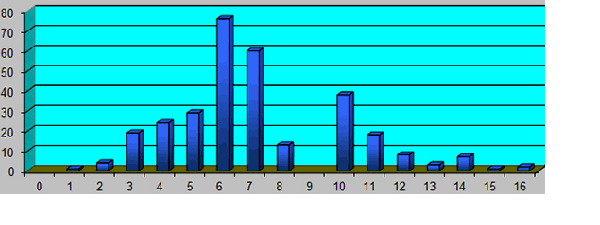
Diagram of the pattern of all known Welrods according to serial numbers. On the horizontal axis, “0” are pistols
with serial numbers 0 through 999. “1” represents serial numbers 1.000 through 1.999 and so forth.
The vertical axis represents the number of registered pistols (updated June, 2012).
It has proven impossible to pinpoint exactly when the first pistol was dropped over the kingdom, but in paragraph 15 in an extensive correspondence from the Danish S.O.E. Chief Flemming B. Muus aka “Jam” to Commander R. C. Hollingworth aka “CHOP”, dated July 31, 1943, “Jam” writes:
[quote]"Rubber Pistol. Have heard of such an instrument. In case of delivery the package must be marked “To be opened by JAM only”. The advantage is supposedly the complete sound suppression."[/quote]
So at this point in time it must have been relatively unknown to the resistance movement. It is equally difficult to ascertain how many in total were dropped, but according to David B. Lampe author of The Savage Canary from 1957, we received about 150. He writes:
[quote]"Although mass-produced in Britain during World War II, none of these silent weapons has been displayed in armament museums, for they were created specifically for the unmentionable assassination of traitors. Altogether about 150 reached Denmark during the occupation."[/quote]
A drop in Grib forest at Smorstenen April 12, 1945, contained 18 Welrod pistols, and another in Gronholt hedge February 26, 1945 and in March 23, 1945 in Hobro in Jutland also contained Welrod pistols. Unfortunately it is not known how many. Additionally a number of drops earlier during the occupation contained Welrods, and some of the in total 53 deployed SOE agents, four of whom made the trip twice, were most likely equipped with the Welrod.
In the fall of 1943, the parachute agents Ole Geisler aka ”Aksel” and Jens Lillelund aka ”Finn” planned to assassinate Norway’s Reichskommisar Josef Terboven during a visit to Denmark. Josef Terboven who was a top Nazi and Norway’s answer to Czechoslovakia’s Reinhard Heydrich, was to be shot in his suite at the Palace Hotel in Copenhagen. For the job “Axel” presented the first Welrod seen in Denmark. Two “Holger Danske” (a group within the resistance movement) members carrying each their Welrod, was to disguise themselves as waiters and shoot Josef Terboven in his room. The plan was aborted however, as it was estimated that the gain by the liquidation seen from a military perspective, would not measure up to the inevitable retaliations that would be carried out on already captured members of the resistance movement as well as on innocent civilians. The pistol was in 1966 donated to the Museum of Danish Resistance by Jens Lillelund.
The latest officially known instances of the Welrod’s use in Denmark are as follows:
December 14, 1943: Jens Lillelund aka “Finn” and Bent Faurschou-Hviid aka ”The Torch” attempts to liquidate the informant Mrs. Hedvig Delbo in her apartment in Osterbro, Copenhagen. A second attempt is carried out successfully on March 19, 1944 by Gunner Dyrberg with a STENgun.
Again in December 1943: Jorgen Rojel borrows a Welrod from parachute agent Jens Jacob Jensen aka “Jens” aka “Pudding” to carry out a liquidation.
October 11, 1944: Henning Roge aka ”Max” tried with a Welrod to kill the infamous informant Henry Meister on Vesterbrogade in Norrsundby. Henry Meister is wounded in the stomach and immediately return fire thereby killing “Max”.
November 17, 1944: Mrs. Frederikke Rungager, age 37, is liquidated at Aarhus County Hospital with a Welrod by a member of the Staal group.
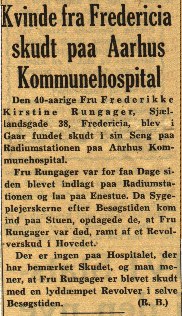
The article advertising Mrs. Rungagers decease.
(Click for English translation).
It should be noted that back in those days too, the press utterly uncritically used the term “revolver” or “pistol”, whenever the referral was to a handgun regardless of type or make. The, in these instances erroneous designations, should therefore not be attributed any specific significance.
In the archives of The Museum of Danish Resistance is a report from the Technical Department of the Federal Police, regarding an investigation of a Welrod pistol. According to the report, the Welrod was used in an assassination attempt on Mrs. Hedvig Delbo December 14, 1943, as well as the liquidation of Mr. Nordahl in Aarhus in January 3, 1944 and an unnamed person in Copenhagen, April 19, 1944 respectively.
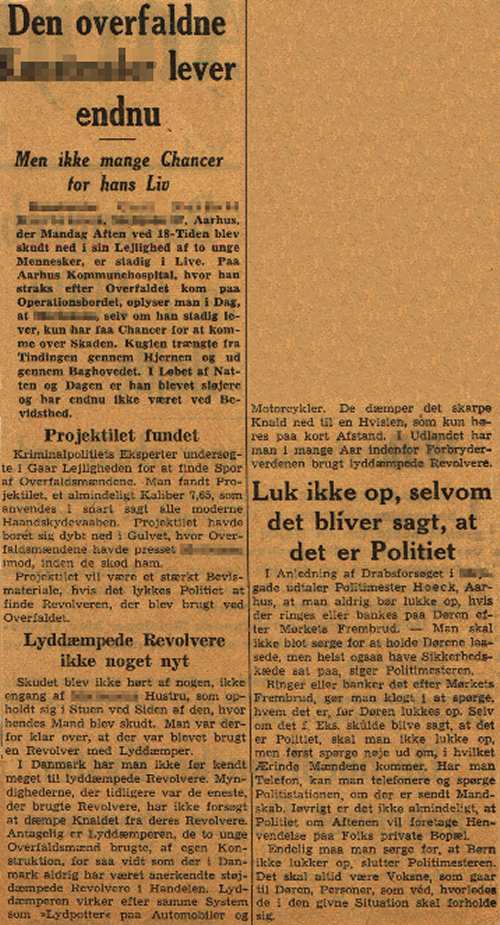
The liquidation in Aarhus January 3, 1944. It was not unknown to the police that suppressed pistols were used for assassinations.(Click for resume in English.)
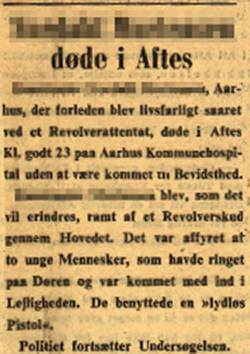
Article from January 6, 1944. (Click for English translation).
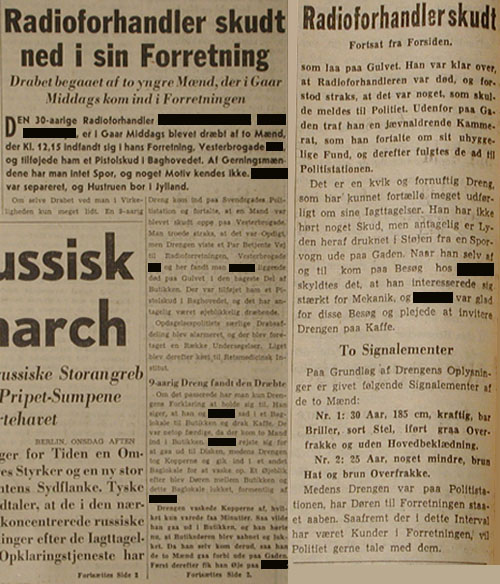
Article describing the liquidation in Copenhagen, April 19, 1944. (Resume in English is not available for the moment).
In the beginning of December 1944, Svend Otto Nielsen aka ”John” on request from England carried out a spectacular operation against the German fighter planes at Kastrup Airport. He was supposed to steal a newly developed locating unit from a parked night fighter. The operation was carried out with the help from an airport employee named Knud Helge Hejl. Unfortunately they were discovered by a German patrol and Knud Helge Hejl got captured. John however got away by crawling several kilometers on his hands and knees. During his escape he shot and killed a German sentry with his Welrod.
To the less dramatic accounts of the Welrod in action belongs the story of “The Torch” who around Christmas 1943 shoots a swan in Frederiksberg gardens and serves it for his friends at a later festive occation.
In June 1944 Kaj Jensen a member of the illegal resistance group BOPA used a Welrod during the one hour long raid on Hærens Våbenarsenal (the army’s production facility). No details on how it was used other than to safeguard the employees and guards. Kaj Jensen was killed in action on Martz 16, 1945.
Several of the airdropped weapons and explosive were captured and used by the Germans against the resistance, but also against the ordinary noncombatant Danish citizen. Somehow they found a profound irony in fighting the resistance with weapons delivered by the Allied. The Peter-group, a terror organization devised by SS Reichsführer Heinrich Himmler, made it their signature only to use captured weapons and explosives.
In an effort to fight and suppress the resistance activity, SS Standartenfürer Otto Anton Rolf Skorzeny on behalf of Heinrich Himmler created a “Sonderkommando Dänemark” which sole purpose was to kill famous or otherwise well-known or productive Danish citizen, and perform terror by blowing up amusement parks, cinemas, trains, trams and other public friendly places. It was also decided that for every German killed in Denmark, 5 Danish citizens were to be killed in retaliation.
In charge he put Hauptsturmführer Otto Alexander Schwerdt but he also ordered the SS men Louis Nebel and Anton Gföller to assist him. Together they recruited several men, both Germans and native Danes sympathizing with the German ideology, among them the Danish speaking SS Oberscharfürer Kurt Carstensen. The group was named the Peter-group (“Unternehmung Peter” in German); the name was created from Schwedt’s cover name “Peter Schäffer”.
On December 30, 1943 around 06:30pm Otto Schwerdt, Anton Gföller, Louis Nebel, Ludvig Huf and Kurt Carstensen all members of the Peter-Group nocked on the door to the apartment of Editor Christian Dam in Copenhagen. Dam’s wife let them in. Schwerdt and Nebel each had a Welrod that they had test fired the same day. Gföller stayed guard outside while Schwerdt, Huf, Carstensen and Nebel went with Dam to his study room. Inside the room Nebel pulled his Welrod but Dam immediately jumped him and got hold on the suppressor tube and they both fell to the floor. Schwerdt intervened and in all three shot were fired. Dam was hit in the back and left thigh but also took a bullet to the head fracturing a part of his skull and left eye. All though critical injured Dam survived the assassination attempt. The Peter-Group escaped without injuries.
On February 3, 1944 around 06:00pm High Court lawyer Holger Christensen is on his way home after a long day at work. He didn´t notice that he was followed by SS Unterscharfürer Fritz Himmel from Sonderkommando Dänemark, and little did he know that Oberfähnrich Droos also from Sonderkommando Dänemark was positioned in the shadows only 30 meters from his entrance door. When Christensen had passed Droos by about 10 meters he raised his Welrod pistol, and fired one shot into the back of his head. The full jacketed projectile pierced his Italian Borsalino hat, the back of his skull, went through the brain and exited through his forehead right above his right eye. Christensen was dead before he hit the ground.
On August 30, 1944 around 08:00 am cand.scient.techn. I.E. Snog-Christensen was kidnapped in front of his home by Henning Bothildsen Nielsen, Hauptsturmführer Henning Brøndum, Schwerdt, Ludvig Huf, Otto Wagner and the SS Unterscharfürer Fritz Himmel. They drove him to a safe house at the beach in Snekkersten owned by the German Sicherheitsdienst. Inside the house they waited until the sun had set, and when it was dark they took him to the beach telling him that they expected a boat to arrive anytime soon, and that there was a person on board that they need him to identify. When they reached the beach and Snog-Christensen faced the ocean, Otto Wagner sneaked up behind him and shot him with his Welrod in the back of the head. He collapsed without a sound and was dead before hitting the sand.
On January 24, 1945 around 12:00 pm William Prieme, a well know member of the parliament was shot and killed by a shot in the head on the street in broad daylight. The killing was executed by Kurt Heel and Bothildsen Nielsen from the notorious Peter-group. They sneaked up behind Prieme and then Heel fired his Welrod into the back of his head. Prieme's hat was blown off from the impact and for a second or two Prieme just stood still, then he slowly fell forward like a piece of lumber. The killing was done in retaliation for the resistances assassination of the Nazi Chief of the Schalburg Corps, Lieutenant T. I. P. O. Madsen on January 22, 1945.
There is no doubt that the Welrod has seen far more action than above mentioned accounts, but as I know only of second hand reports with no official documentation to support the claims I have chosen not to list them here.
Below are 2 rare photos of a resistance fighter and his Welrod.
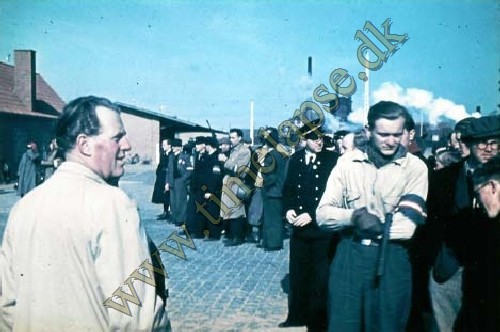
The photo is from Nykøbing Falster, Denmark date 05.05.1945
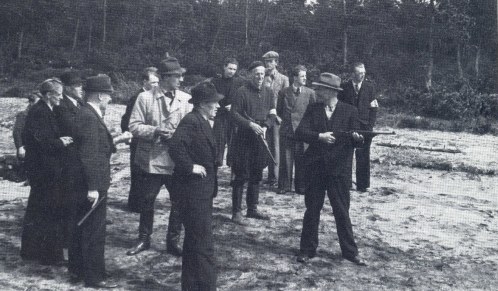
Target practice at Frodeslund, Denmark after the liberation.
Newly (2002) released documents (HS 8/199) from the archives of S.O.E in the National Archives UK, reveals the planning of "Operation Execution Month" in June 22, 1943. The operation called for the occupied countries to simultaneously assassinate as many Gestapo and SS officials as possible within a given month. For this purpose alone, a message went out to increase the production of Welrods in order to meet the demands of the pending campaign. Below I have copied the text of a document containing a draft of the plan. Unfortunately this exact document is not dated, but must necessarily be from June, 1943.
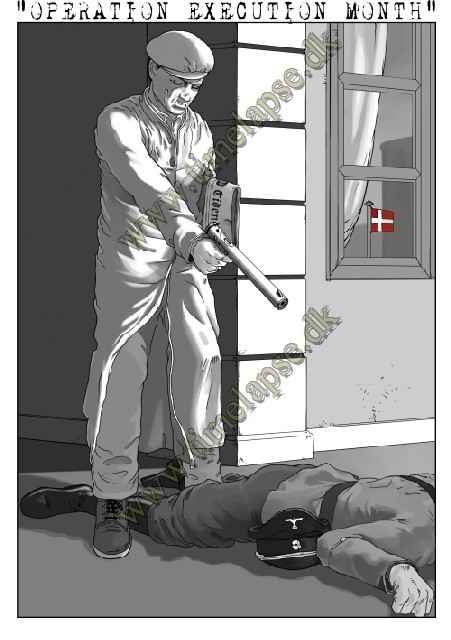
Drawing illustrating a Danish resistance fighter liquidating a GESTAPO official.
"EXECUTION" Campaign.
Preliminary discussion shows that there are considerable possibilities in organising a widespread "execution" campaign in occupied territories against Gestapo and S.S. officials.
It is considered that to achieve the maximum effect it should be carried out simultaneously in all countries.
It is suggested that as a start a certain month be declared an "execution" month. Sufficient time must be allowed for thorough preparation, for the necessary distribution of suitable weapons, and for the posting of death warrants.
The Welrod appears to be the most suitable weapon, as it is silent and easily concealed. On present information the production situation is most unsatisfactory. 500 have been ordered, but there is no indication when they will be delivered.
It might be best to declare September or October as the "execution" month. This would give time for preparation and would be a warning to the Germans as to what to expect during the long dark winter nights.
But a decision will depend on the Welrod situation and, until this is settled, the date cannot be communicated to the field.
Production of Welrods.
This will have to be accelerated if we are to carry out a campaign of "execution" in the near future.
Below is an excerpt from the account of the meeting at S.O.E, June 22, 1943. I found the account in The National Archives UK, but as the entire account is far too voluminous to print here, I have kept it to the text relevant to the subject.
S.O.E. COUNSIL
MINUTES of MEETING held on TUESDAY, 22.6.43.
PRESENT: CD, V/CD, A/CD, AD/E, D/FIN, AD/S, AD/Z, D/Plans, AD/4, AD/N.
ABSENT: A.D.3.
In attendance: PSO.1. and PSO.2.
[quote]
62. OPERATIONS DIRECTORATE - "Execution" Campaign.
Counsil considered a paper by AD/E recommending a concerted execution campaign against Gestapo and S.S. officials, mainly by means of the Welrod. AD/Z said that the total order for Welrods was 600, of which 100 were due for delivery in July and he could with reasonable certainty promise that these 100 would be available in August.
DECISIONS:
(a) AD/E's proposal was approved but should be for the most part confined to civilian officials rather than soldiers; We should concentrate on Germans rather than on Quislings.
(b) AD/Z's total order for 600 was confirmed but AD/4 and D/Plans should ascertain the requirements of Far Eastland Middle East respectively.
(c) AD/Z should pres forward production so as to ensure delivery of 100 Welrods by the end of August and at least 100 for every succeeding month.
(d) The target date for the campaign should be 1st. October.
[/quote]
68. RESEARCH - Welman.
AD/Z reported that one Lancaster III had been allotted for experimental transport purposes. [/quote]
The operation was never carried out, probably due to fear of retaliation from the occupational forces. The Allied must have begun to realize the incalculable consequences of the previously carried out “Operation Anthropoid” at this point. The terrible massacre at the Czech town Lidice close to Prague, where the entire male population was executed, all the women were deported, and the town itself was literally razed to the ground with bulldozers in retaliation for the assassination of SS Obergruppenführer Reinhard Heydrich on May 27, 1942 by two Czech S.O.E agents.
In the aftermath, thousands of randomly picked people were executed, and there was no reason to believe that the Germans would be lenient on Denmark, Norway, Holland, Belgium or France if similar assassinations on SS officials were to take place here. The Nazis had sent a clear message that the killing of German officials would not be tolerated.
It is a reasonable assumption that the, after the circumstances, many Welrods that came to Denmark were dropped here with "Operation Execution Month". in mind. Sadly we can conclude that the ruthless terror and killing of civilians by the Nazis had a, for them, beneficial effect in their battle against the continuous dissemination and work of the resistance movement after all.
|









